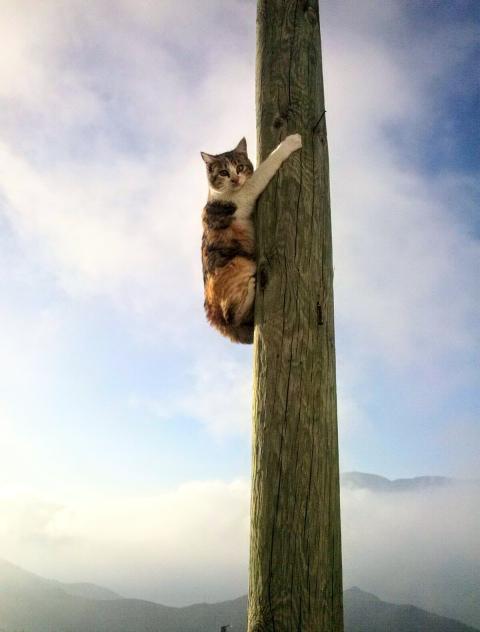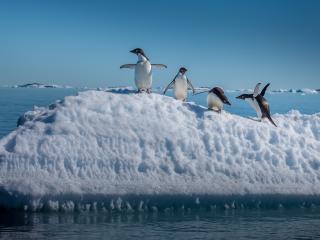The law of nature
Birdsong fills his study – a live feed from a webcam far away in the South-African bush. Arie Trouwborst, Associate Professor in Environmental Law, often listens to it when he is working, he says: "These background sounds are very soothing". That calm was much needed at the time his cat-study was all over the news.
He has been involved in nature conservation since his childhood. Predators have always fascinated him, but late last year he himself, in a manner of speaking, fell prey to one of these – the domestic cat – because of his research and, more especially, its reception. Trouwborst had of course expected some public response to the research publication he co-authored with Han Somsen and which appeared in the Journal of Environmental Law. In it they argue that allowing domestic cats to roam freely outdoors falls within the scope of the ‘deliberate killing’ of birds. And European nature conservation rules require national governments in the EU to prohibit and effectively prevent such ‘deliberate killing’.

Cat-induced bird mortality is higher than through all other causes combined
Domestic cats rank in the top 3 of most harmful alien species worldwide: every year they kill billions of birds, mammals, and reptiles, including endangered species. “We are acutely aware of bird mortality brought on by windmills, by high-voltage cables, by illegal hunting,” Trouwborst observes. “Yet cat-induced mortality is higher than the number of animal deaths through all of these other causes combined.”
Fierce reactions
The quantity and fierceness of the reactions to the press release on his research went well beyond what he had expected. Trouwborst: “We received requests for interviews, cameras and all, from all over the world, and in a very short time our article had the highest Altmetric score – an indicator of press and social media attention – of all legal research publications in the year 2019 worldwide. Our work was welcomed by ecologists and fellow jurists, and from the general public, too, we received a great deal of positive feedback. Many others, however, appeared to have been stung by a wasp, judging by what they wrote in their emails and on social media. I have a truckload of messages that are just too awful for words. To the extent these messages contained any arguments at all, these were limited to such platitudes as ‘are there really no more pressing concerns?’, or ‘aren’t cats part of nature, too?’ ’’
Politicians vied for sharp comments. The Dutch Minister of Agriculture, Carola Schouten, opined that there are more serious matters. An MP for the Dutch Christian democrat party (CDA) called the article ‘rubbish’ without appearing to have read it, an MP for the Dutch liberal party (VVD) dismissed the article as ‘absolute madness’, and yet another parliamentarian referred to ‘deranged pseudoscientists’.
The difference is one of perception
“Clearly driven by fear of losing votes, politicians hastened to reassure cat owners. It was all much more intense than I had anticipated. Surely, we can talk about this calmly? What we are looking at is a habit of part of the general public that is harmful to nature preservation. Remember that dog owners are fined when their pets chase or kill wildlife. The difference is one of perception. Keeping domestic cat indoors at all times is not an easy transition. We will have to learn how to take care of indoor cats differently, for example by playing with them more, and the government needs to think about how this transition can be facilitated. All of this will take time, but twenty years from now we might look back and be astounded that there once was a time when people felt it was perfectly okay to allow cats to roam outdoors.”

None of this really throws Trouwborst. To the contrary, a second article on tackling free-ranging cats was recently published. It centers on international treaties that impose major restrictions regarding harmful exotic domestic animals and points out that here too governments are doing a poor job of meeting their obligations.
The Tilburg research has prompted formal questions in parliament from D66, the Dutch liberal democrat party, to the Minister of Agriculture. “And the matter could of course be taken to court. If that were to happen, I reckon there’d be a fair chance it might lead to a roaming ban for domestic cats.”
Greatest challenges of our era
“I’ve been involved in nature conservation ever since I was a young boy and in my spare time I often ventured into nature. My dream was to become a park ranger somewhere in Africa to protect elephants and other wildlife, or to work as a biologist. But I wasn’t very good at sciences. At secondary school I contacted the World Wildlife Fund, Greenpeace, and other NGOs, asking them which academic career I could usefully pursue to help protect nature. They told me that few lawyers specialized in nature conservation and that more were sorely needed. So to law schooI I went and there I stayed.”
It is simply wonderful that in teaching and research I get to engage in nature preservation
“This work suits me; it is simply wonderful that in teaching and in research I get to engage in nature preservation, spend time contemplating it as well as occasionally being of practical use through research and consultancy. The global community of legal experts in nature conservation is a small one, but as it so happens Tilburg University has a great deal of in-house expertise in this particular area.”
“Climate change and loss of biodiversity are perhaps the greatest challenges of our era. Our economies must operate within ecological boundaries. The law has a clear role here. I myself serve on advisory bodies, such as the Large Carnivore Initiative for Europe, a group of experts giving advice to governments and international organizations about large predators. This specialist group is working closely with the European Commission as well as with the Council of Europe in the context of the 1979 Bern Convention on nature conservation. Practical conservation issues often have legal questions behind them. This has provided me with opportunities to get my teeth into legal issues such as the legal status of the wolf in different parts of Europe, the establishment of wolf-free zones and such questions as when may wolves be shot.”
Text continues below the photo >>

The Big Picture
“Circumstances are compelling us, I believe, with increasing urgency to look at the big picture, in terms of both time and space. Take the wolf. In Western Europe it is a tough struggle to ensure the return of this predator to countries that had worked long and hard to exterminate it. Every dead sheep fuels the debate. Yet at the same time many people here find it important that lions and elephants do not become extinct in poor African countries – but such preservation is literally being paid for with human lives there. How consistent and how just is that?”
“And now into the time machine to try and answer the question: what is natural? Was the rural landscape of a century ago natural? 50,000 years ago – a mere blink in the history of life on earth – Europe was teeming not just with red deer, boar, wolves, and brown bears, but also with elephants, rhinoceros, aurochs, giant deer, lions, cave bears, and hyenas. All gone, most likely due in large measure to our early ancestors. The result: a much impoverished environment. And over the last couple of centuries battered and wounded ecosystems have had to endure renewed assaults that use ever more advanced technology. The recipe is always the same: a badly managed combination of innumerable individual human interests and opinions, with biodiversity being the loser throughout.”
I remain optimistic
“The good news is that nature is resilient: if given an opportunity, Mother Nature will seize it. Biologists believe that we can preserve about 85% of today’s species if on half of the earth’s surface (distributed proportionately among ecosystems) we give priority to nature. In all this, it is terrifically interesting to think about the role of the law. I remain optimistic: we know what needs to happen to turn the tide and none of it is impossible.”
Also in Tilburg University Magazine
Date of publication: 16 July 2020




